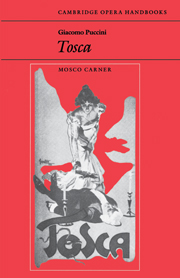Book contents
- Frontmatter
- General preface
- Contents
- List of illustrations
- 1 Sardou and his La Tosca
- 2 Naturalism in opera: verismo
- 3 Genesis of Tosca
- 4 Synopsis
- 5 Play and opera: a comparison
- 6 First production and critical history
- 7 Interpretation: some reflections
- 8 Style and technique
- 9 Musical and dramatic structure
- 10 Analysis: Act I in perspective
- 11 Tosca in the United States
- Notes
- Select bibliography
- Discography by Malcolm Walker
- Index
- Frontmatter
- General preface
- Contents
- List of illustrations
- 1 Sardou and his La Tosca
- 2 Naturalism in opera: verismo
- 3 Genesis of Tosca
- 4 Synopsis
- 5 Play and opera: a comparison
- 6 First production and critical history
- 7 Interpretation: some reflections
- 8 Style and technique
- 9 Musical and dramatic structure
- 10 Analysis: Act I in perspective
- 11 Tosca in the United States
- Notes
- Select bibliography
- Discography by Malcolm Walker
- Index
Summary
Tosca is, strictly speaking, not a music-drama in the accepted (Wagnerian) sense, but rather the early herald of the modern musictheatre, that is, a drama with a powerful, action-packed plot round which the music coils and recoils with snake-like suppleness and pliancy. Were it not for the lyrical episodes in which Puccini the musician asserts himself against Puccini the dramatist, the music might be denned as a function, or extension in sound, of the action. Nowadays when Salome and Elektra form part of the ordinary repertory, and when Wozzeck and, latterly, the three-act Lulu have come into their own – all these operas partake of the nature of musictheatre – it is difficult to realize the daring novelty that Tosca represented in the early 1900s. On the face of it, the subject seemed to defy operatic treatment, and it is a measure of Puccini's stature as a musical dramatist that he not only overcame its apparent unsuitability for musicalization but found valid musical equivalents for such scenes as Cavaradossi's torture and Scarpia's sexual frenzy. Sardou's play has vanished into limbo while Puccini's opera has been proclaiming its extraordinary vitality in countless productions over more than eight decades. Moreover, Tosca provides an outstanding example, like the large majority of successful operas, of the composer's acute instinctive awareness of the inner and, largely, imponderable laws that govern action and music as expressed in the right balance between the dramatic (action-music) and the lyrical (aria, duet).
- Type
- Chapter
- Information
- Giacomo Puccini: Tosca , pp. 91 - 100Publisher: Cambridge University PressPrint publication year: 1985



